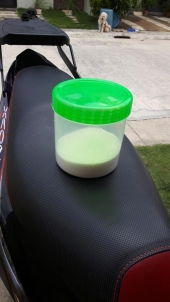
 4
4








 2
2




If you're in doubt, try opening up one of the buckets to see how the contents look. If you have any doubts, I'd be wary. If you ever are in a life-or-death survival situation where your food stores are all you have, food poisoning could be lethal. And painful.But I want to know if I have to redo my previous buckets. 5 gallon buckets aren't air-tight: oxygen gradually gets absorbed in through the sides.
Thanks, Y'all!
 11
11




Invasive plants are Earth's way of insisting we notice her medicines. Stephen Herrod Buhner
Everyone learns what works by learning what doesn't work. Stephen Herrod Buhner
 9
9




 9
9




 3
3




Nick Kitchener wrote:Ideally you are storing bulk food as part of your lifestyle, not a doomsday scenario and so bulk storage goes hand in hand with managing the warehouse so to speak.
If you have 100lb of rice and you actually eat rice then instead of squirreling away 100lbs, you cycle it through your regular consumption so you are always eating the old stock and replenishing it with the fresh stock.
 3
3




Jamin Grey wrote:This blog claims they ate 18 year old pinto beans[/url] that was sealed in a #10 can, and the beans softened well-enough, though they used some baking soda to ate the soaking process.
I wonder if this is the exception to the rule, or if other methods of storing beans will have equivalent results. Anyone know?
Invasive plants are Earth's way of insisting we notice her medicines. Stephen Herrod Buhner
Everyone learns what works by learning what doesn't work. Stephen Herrod Buhner
 6
6




Anne Miller wrote:Probably the cooking method has a big impact on how they turn out. Did the blog say if they pressure cooked them or how long they were soaked? I am betting they used a pressure cooker.
 5
5




Invasive plants are Earth's way of insisting we notice her medicines. Stephen Herrod Buhner
Everyone learns what works by learning what doesn't work. Stephen Herrod Buhner
 7
7




 6
6




Em Bracken wrote:Some considerations that haven't been mentioned yet;
Vacuum sealing creates a lot of waste plastic that mostly gets thrown away after a single use
 5
5




Em Bracken wrote:
Vacuum sealing creates a lot of waste plastic that mostly gets thrown away after a single use
 5
5




Jamin Grey wrote:I bought some mylar bags (which are expensive!) and am about to do some more buckets, with mylar. But I want to know if I have to redo my previous buckets. 5 gallon buckets aren't air-tight: oxygen gradually gets absorbed in through the sides.
Blog: 5 Acres & A Dream
Books: Kikobian Books | Permies Digital Market
 4
4




Jamin Grey wrote:Hi! I've put about a hundred pounds of rice and pinto beans through 48 hours of freezing in the freezer, then thawing 24 hours, then freezing 48 hours, then thaw then freeze - three cycles of 48 hours of freezing.
Then I packed them in five gallon buckets, but without using mylar or dry ice (I just used oxygen absorbers in the bucket).
Are these fine for decades of storage?
I bought some mylar bags (which are expensive!) and am about to do some more buckets, with mylar.
But I want to know if I have to redo my previous buckets. 5 gallon buckets aren't air-tight: oxygen gradually gets absorbed in through the sides.
 3
3




 1
1




 2
2




Tony Masterson wrote:About freezing.
Would be a good or bad idea to put all my closed bucket outdoors for a week when it's freezing? (to kill off any bugs that somehow got in. Like hatched eggs, and whatever.)
Or would that cause condensation issues? Perhaps add a moist absorber?
 4
4




 3
3




At my age, Happy Hour is a nap.
 4
4




 3
3




Life on a farm is a school of patience; you can't hurry the crops or make an ox in two days.
Henri Alain
 6
6




 Thanks for the useful discussion!
Thanks for the useful discussion!  3
3





|
Any sufficiently advanced technology will be used as a cat toy. And this tiny ad contains a very small cat:
Freaky Cheap Heat - 2 hour movie - HD streaming
https://permies.com/wiki/238453/Freaky-Cheap-Heat-hour-movie
|

